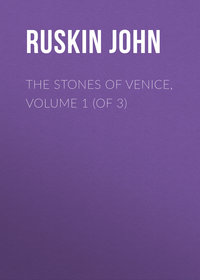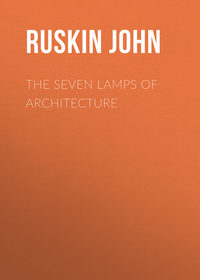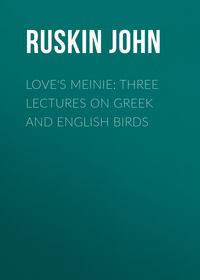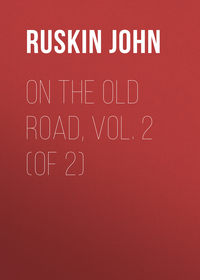 полная версия
полная версияMornings in Florence
You cannot compare the subjects on the tower itself; but of my series of photographs take 6 and 21, and put them side by side.
I need not dwell on the conditions of resemblance, which are instantly visible; but the difference in the treatment of the heads is incomprehensible. That of the Tubal Cain is exquisitely finished, and with a painter's touch; every lock of the hair laid with studied flow, as in the most beautiful drawing. In the 'Sculpture,' it is struck out with ordinary tricks of rapid sculptor trade, entirely unfinished, and with offensively frank use of the drill hole to give picturesque rustication to the beard.
Next, put 22 and 5 back to back. You see again the resemblance in the earnestness of both figures, in the unbroken arcs of their backs, in the breaking of the octagon moulding by the pointed angles; and here, even also in the general conception of the heads. But again, in the one of Painting, the hair is struck with more vulgar indenting and drilling, and the Gothic of the picture frame is less precise in touch and later in style. Observe, however,—and this may perhaps give us some definite hint for clearing the question,—a picture-frame would be less precise in making, and later in style, properly, than cusped arches to be put under the feet of the inventor of all musical sound by breath of man. And if you will now compare finally the eager tilting of the workman's seat in 22 and 6, and the working of the wood in the painter's low table for his pots of colour, and his three-legged stool, with that of Tubal Cain's anvil block; and the way in which the lines of the forge and upper triptych are in each composition used to set off the rounding of the head, I believe you will have little hesitation in accepting my own view of the matter—namely, that the three pieces of the Fathers of the Arts were wrought with Giotto's extremest care for the most precious stones of his tower; that also, being a sculptor and painter, he did the other two, but with quite definite and wilful resolve that they should be, as mere symbols of his own two trades, wholly inferior to the other subjects of the patriarchs; that he made the Sculpture picturesque and bold as you see it is, and showed all a sculptor's tricks in the work of it; and a sculptor's Greek subject, Bacchus, for the model of it; that he wrought the Painting, as the higher art, with more care, still keeping it subordinate to the primal subjects, but showed, for a lesson to all the generations of painters for evermore,—this one lesson, like his circle of pure line containing all others,—'Your soul and body must be all in every touch.'
I can't resist the expression of a little piece of personal exultation, in noticing that he holds his pencil as I do myself: no writing master, and no effort (at one time very steady for many months), having ever cured me of that way of holding both pen and pencil between my fore and second finger; the third and fourth resting the backs of them on my paper.
As I finally arrange these notes for press, I am further confirmed in my opinion by discovering little finishings in the two later pieces which I was not before aware of. I beg the masters of High Art, and sublime generalization, to take a good magnifying glass to the 'Sculpture' and look at the way Giotto has cut the compasses, the edges of the chisels, and the keyhole of the lock of the toolbox. For the rest, nothing could be more probable, in the confused and perpetually false mass of Florentine tradition, than the preservation of the memory of Giotto's carving his own two trades, and the forgetfulness, or quite as likely ignorance, of the part he took with Andrea Pisano in the initial sculptures. I now take up the series of subjects at the point where we broke off, to trace their chain of philosophy to its close. To Geometry, which gives to every man his possession of house and land, succeed 21, Sculpture, and 22, Painting, the adornments of permanent habitation. And then, the great arts of education in a Christian home. First—
23. Grammar, or more properly Literature altogether, of which we have already seen the ancient power in the Spanish Chapel series; then,
24. Arithmetic, central here as also in the Spanish Chapel, for the same reasons; here, more impatiently asserting, with both hands, that two, on the right, you observe-and two on the left-do indeed and for ever make Four. Keep your accounts, you, with your book of double entry, on that principle; and you will be safe in this world and the next, in your steward's office. But by no means so, if you ever admit the usurers Gospel of Arithmetic, that two and two make Five. You see by the rich hem of his robe that the asserter of this economical first principle is a man well to do in the world.
25. Logic. The art of Demonstration. Vulgarest of the whole series, far too expressive of the mode in which argument is conducted by those who are not masters of its reins.
26. Song.
The essential power of music in animal life. Orpheus, the symbol of it all, the inventor properly of Music, the Law of Kindness, as Dædalus of Music, the Law of Construction. Hence the "Orphic life" is one of ideal mercy, (vegetarian,)—Plato, Laws, Book VI., 782,—and he is named first after Dædalus, and in balance to him as head of the school of harmonists, in Book III., 677, (Steph.) Look for the two singing birds clapping their wings in the tree above him; then the five mystic beasts,—closest to his feet the irredeemable boar; then lion and bear, tiger, unicorn, and fiery dragon closest to his head, the flames of its mouth mingling with his breath as he sings. The audient eagle, alas! has lost the beak, and is only recognizable by his proud holding of himself; the duck, sleepily delighted after muddy dinner, close to his shoulder, is a true conquest. Hoopoe, or indefinite bird of crested race, behind; of the other three no clear certainty. The leafage throughout such as only Luca could do, and the whole consummate in skill and understanding.
27. Harmony.
Music of Song, in the full power of it, meaning perfect education in all art of the Muses and of civilized life: the mystery of its concord is taken for the symbol of that of a perfect state; one day, doubtless, of the perfect world. So prophesies the last corner stone of the Shepherd's Tower.
1
"Cum in universe orbe non reperiri dicatur quenquam qui sufficientior sit in his et aliis multis artibus magistro Giotto Bondonis de Florentia, pictore, et accipiendus sit in patriâ, velut magnus magister."—(Decree of his appointment, quoted by Lord Lindsay, vol. ii., p. 247.)
2
See, on this subject generally, Mr. R. St. J. Tyrwhitt's "Art-Teaching of the Primitive Church." S. P. B. K., 1874.
3
Footnote: I have never obtained time for any right study of early Christian church-discipline,—nor am I sure to how many other causes, the choice of the form of the basilica may be occasionally attributed, or by what other communities it may be made. Symbolism, for instance, has most power with the Franciscans, and convenience for preaching with the Dominicans; but in all cases, and in all places, the transition from the close tribune to the brightly-lighted apse, indicates the change in Christian feeling between regarding a church as a place for public judgment or teaching, or a place for private prayer and congregational praise. The following passage from the Dean of Westminster's perfect history of his Abbey ought to be read also in the Florentine church:—"The nearest approach to Westminster Abbey in this aspect is the church of Santa Croce at Florence. There, as here, the present destination of the building was no part of the original design, but was the result of various converging causes. As the church of one of the two great preaching orders, it had a nave large beyond all proportion to its choir. That order being the Franciscan, bound by vows of poverty, the simplicity of the worship preserved the whole space clear from any adventitious ornaments. The popularity of the Franciscans, especially in a convent hallowed by a visit from St. Francis himself, drew to it not only the chief civic festivals, but also the numerous families who gave alms to the friars, and whose connection with their church was, for this reason, in turn encouraged by them. In those graves, piled with standards und achievements of the noble families of Florence, were successively interred—not because of their eminence, but as members or friends of those families—some of the most illustrious personages of the fifteenth century. Thus it came to pass, as if by accident, that in the vault of the Buonarotti was laid Michael Angelo; in the vault of the Viviani the preceptor of one of their house, Galileo. From those two burials the church gradually be same the recognized shrine of Italian genius."
4
"Seven years a prisoner at the city gate,Let in but his grave-clothes."Rogers' "Italy."5
Perhaps it is only the restorer's white on the ground that stops; but I think a restorer would never have been so wise, but have gone right up to the outline, and spoiled all.
6
I venture to attribute the wiser note to Signor Cavalcasella because I have every reason to put real confidence in his judgment. But it was impossible for any man, engaged as he is, to go over all the ground covered by so extensive a piece of critical work as these three volumes contain, with effective attention.
7
I observe that recent criticism is engaged in proving all Etruscan vases to be of late manufacture, in imitation of archaic Greek. And I therefore must briefly anticipate a statement which I shall have to enforce in following letters. Etruscan art remains in its own Italian valleys, of the Arno and upper Tiber, in one unbroken series of work, from the seventh century before Christ, to this hour, when the country whitewasher still scratches his plaster in Etruscan patterns. All Florentine work of the finest kind—Luca della Robbia's, Ghiberti's, Donatello's, Filippo Lippi's, Botticelli's, Fra Angelico's—is absolutely pure Etruscan, merely changing its subjects, and representing the Virgin instead of Athena, and Christ instead of Jupiter. Every line of the Florentine chisel in the fifteenth century is based on national principles of art which existed in the seventh century before Christ; and Angelico, in his convent of St. Dominic, at the foot of the hill of Fésole, is as true an Etruscan as the builder who laid the rude stones of the wall along its crest—of which modern civilization has used the only arch that remained for cheap building stone. Luckily, I sketched it in 1845. but alas, too carelessly,—never conceiving of the brutalities of modern Italy as possible.
8
The floor has been repainted; but though its grey is now heavy and cold, it cannot kill the splendour of the rest.
9
'Fors Clavigera' for September, 1874.
10
For a test of your feeling in the matter, having looked well at these two lower frescos in this chapel, walk round into the next, and examine the lower one on your left hand as you enter that. You will find in your Murray that the frescos in this chapel "were also till lately, (1862) covered with whitewash"; but I happen to have a long critique of this particular picture written in the year 1845, and I see no change in it since then. Mr. Murray's critic also tells you to observe in it that "the daughter of Herodias playing on a violin is not unlike Perugino's treatment of similar subjects." By which Mr. Murray's critic means that the male musician playing on a violin, whom, without looking either at his dress, or at the rest of the fresco, he took for the daughter of Herodias, has a broad face. Allowing you the full benefit of this criticism—there is still a point or two more to be observed. This is the only fresco near the ground in which Giotto's work is untouched, at least, by the modern restorer. So felicitously safe it is, that you may learn from it at once and for ever, what good fresco painting is—how quiet—how delicately clear—how little coarsely or vulgarly attractive—how capable of the most tender light and shade, and of the most exquisite and enduring colour.
In this latter respect, this fresco stands almost alone among the works of Giotto; the striped curtain behind the table being wrought with a variety and fantasy of playing colour which Paul Veronese could not better at his best.
You will find, without difficulty, in spite of the faint tints, the daughter of Herodias in the middle of the picture–slowly moving, not dancing, to the violin music—she herself playing on a lyre. In the farther corner of the picture, she gives St. John's head to her mother; the face of Herodias is almost entirely faded, which may be a farther guarantee to you of the safety of the rest. The subject of the Apocalypse, highest on the right, is one of the most interesting mythic pictures in Florence; nor do I know any other so completely rendering the meaning of the scene between the woman in the wilderness, and the Dragon enemy. But it cannot be seen from the floor level: and I have no power of showing its beauty in words.
11
1st Esdras vi. 24.
12
Ezra i. 3, and 2nd Esdras ii. 3.
13
"Represented" (next to St. Francis before the Soldan, at Assisi) "as seen one night by the brethren, praying, elevated from the ground, his hands extended like the cross, and surrounded by a shining cloud."—Lord Lindsay.
14
"St. Anthony of Padua was preaching at a general chapter of the order, held at Arles, in 1224, when St. Francis appeared in the midst, his arms extended, and in an attitude of benediction."—Lord Lindsay.
15
"A brother of the order, lying on his deathbed, saw the spirit of St. Francis rising to heaven, and springing forward, cried, 'Tarry, Father, I come with thee!' and fell back dead."—Lord Lindsay.
16
"He hesitated, before canonizing St. Francis; doubting the celestial infliction of the stigmata. St. Francis appeared to him in a vision, and with a severe countenance reproving his unbelief, opened his robe, and, exposing the wound in his side, filled a vial with the blood that flowed from it, and gave it to the Pope, who awoke and found it in his hand."—Lord Lindsay.
17
Footnote: "As St. Francis was carried on his bed of sickness to St. Maria degli Angeli, he stopped at an hospital on the roadside, and ordering his attendants to turn his head in the direction of Assisi, he rose in his litter and said, 'Blessed be thou amongst cities! may the blessing of God cling to thee, oh holy place, for by thee shall many souls be saved;' and, having said this, he lay down and was carried on to St. Maria degli Angeli. On the evening of the 4th of October his death was revealed at the very hour to the bishop of Assisi on Mount Sarzana."—Crowe and Cavalcasella.
18
Approximately. Thinking I could find the dimensions of the duomo anywhere, I only paced it myself,—and cannot, at this moment, lay my hand on English measurements of it.
19
There is no philosophy taught either by the school of Athens or Michael Angelo's 'Last Judgment,' and the 'Disputa' is merely a graceful assemblage of authorities, the effects of such authority not being shown.
20
This picture bears the inscription (I quote from the French catalogue, not having verified it myself), "Simon Martini, et Lippus Memmi de Senis me pinxerunt." I have no doubt whatever, myself, that the two brothers worked together on these frescoes of the Spanish Chapel: but that most of the Limbo is Philip's, and the Paradise, scarcely with his interference, Simon's.
21
I can't find my note of the first one on the left; answering to Solomon, opposite.
22
I in careless error, wrote "was given" in 'Fors Clavigera.
23
Atlas! according to poor Vasari, and sundry modern guides. I find Vasari's mistakes usually of this brightly blundering kind. In matters needing research, after a while, I find he is right, usually.
24
Being able to play the piano and admire Mendelssohn is not knowing music.
25
Blunderingly in the guide-books called 'Faith!'
26
Blunderingly called 'Charity' in the guide-books.
27
With cowardly intentional fallacy, translated 'high' in the English Bible.
28
He wrote thus to me on 11th November last: "The three preachers are certainly different. The first is Dominic; the second, Peter Martyr, whom I have identified from his martyrdom on the other wall; and the third, Aquinas."
29
See Fors Clavigera in that year.
30
For account of the series on the main archivolt of St. Mark's, see my sketch of the schools of Venetian sculpture in third forthcoming number of 'St. Mark's Rest.'
31
So also the Master-builder of the Ducal Palace of Venice. See Fors Clavigera for June of this year.
32
The oak and apple boughs are placed, with the same meaning, by Sandro Botticelli, in the lap of Zipporah. The figure of the bear is again represented by Jacopo della Quercia, on the north door of the Cathedral of Florence. I am not sure of its complete meaning.
33
Compare Fors Clavigera, February, 1877.
34
"I think Jabal's tent is made of leather; the relaxed intervals between the tent-pegs show a curved ragged edge like leather near the ground" (Mr. Caird). The edge of the opening is still more characteristic, I think.
35
Prints of these photographs which do not show the masonry all round the hexagon are quite valueless for study.
36
Pointed out to me by Mr. Caird, who adds farther, "I saw a forge identical with this one at Pelago the other day,—the anvil resting on a tree-stump: the same fire, bellows, and implements; the door in two parts, the upper part like a shutter, and used for the exposition of finished work as a sign of the craft; and I saw upon it the same finished work of the same shape as in the bas-relief—a spade and a hoe."
37
Mr. Caird convinced me of the real meaning of this sculpture. I had taken it for the giving of a book, writing further of it as follows:—
All books, rightly so called, are Books of Law, and all Scripture is given by inspiration of God. (What we now mostly call a book, the infinite reduplication and vibratory echo of a lie, is not given but belched up out of volcanic clay by the inspiration of the devil.) On the Book-giver's right hand the students in cell, restrained by the lifted right hand:
"Silent, you, till you know"; then, perhaps, you also.
On the left, the men of the world, kneeling, receive the gift.
Recommendable seal, this, for Mr. Mudie!
Mr. Caird says: "The book is written law, which is given by Justice to the inferiors, that they may know the laws regulating their relations to their superiors—who are also under the hand of law. The vassal is protected by the accessibility of formularized law. The superior is restrained by the right hand of power."
38
In the deep sense of this truth, which underlies all the bright fantasy and humour of Mr. Courthope's "Paradise of Birds," that rhyme of the risen spirit of Aristophanes may well be read under the tower of Giotto, beside his watch-dog of the fold.
39
I mean no accusation against any class; probably the one-fielded statesman is more eager for his little gain of fifty yards of grass than the squire for his bite and sup out of the gypsy's part of the roadside. But it is notable enough to the passing traveller, to find himself shut into a narrow road between high stone dykes which he can neither see over nor climb over, (I always deliberately pitch them down myself, wherever I need a gap,) instead of on a broad road between low grey walls with all the moor beyond—and the power of leaping over when he chooses in innocent trespass for herb, or view, or splinter of grey rock.











